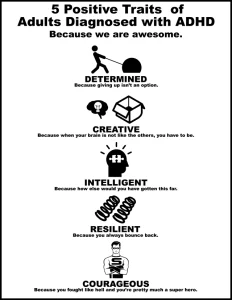(and why it’s often misunderstood for CIS women in particular)
Let’s talk about ADHD
We’ve all seen characters with ADHD on TV and in books etc, try and think of a few examples and I bet they all fit in one stereotypical box; “the naughty young white boy acting out in class”. But not only is this stereotype wrong, it’s actually really harmful!

Historically ADHD was seen as only (or as least predominantly) affecting boys (often white boys, but that’s a whole other subject I’m not qualified to talk about), but evidence shows that many girls do have ADHD, however it is often the inattentive presentation of ADHD which tends to be under-recognised or under-diagnosed, because it doesn’t fit the stereotypical (hyperactive) trope and kids with it aren’t causing problems in the classroom etc; instead they’re just being labelled as ‘day dreamers’ and are left to slowly fall behind or put under pressure to sort themselves out with no support.
Ironically, whilst the Hyperactive/impulsive symptoms are more well-known, due to being more visible, they are in-fact less common than inattentive ones, both for women and adults in general. These symptoms often become more “internal” when they persist; as adults learn to manage their hyperactivity; which historically led medical practitioners to believe that ADHD symptoms decreased after childhood, which is now known to be incorrect. Currently 2.8% of adults in the UK have ADHD, but many are undiagnosed and the number of adult diagnosis’s is increasing every year; it is believed that as many as 1 in 20 adults in the UK are likely to have ADHD.
So, what is ADHD?
ADHD as a developmental disorder that affects the brain’s executive functions. Executive functions are the cognitive processes that organises thoughts and activities, prioritises tasks, manages time efficiently, and makes decisions. They’re basically the little office manager that lives in our heads.
Research suggests that many people with ADHD tend to be perfectionists who fear getting things wrong; they struggle to cope with failure or letting others down. Most people with ADHD are seen to be extremely empathetic to others’ emotions and suffer from Rejection Sensitivity Dysphoria (an extreme emotional sensitivity and pain triggered by a sense of falling short—failing to meet their own high standards or others’ expectations; being rejected or criticized by important people in their life.)
Many people with ADHD struggle with procrastination issues; at one time this was seen as people with ADHD being ‘lazy’ or ‘stupid’ however, research has shown that due to issues with executive functioning, people with ADHD struggle with ‘knowing where to begin’. When the size or scale of the work needed to complete things is ‘too big’, or ‘there is too much to do’ they are unable to start for fear they won’t be able to finish and will only fail or disappoint.
This often leads to people with ADHD leaving everything to the end when a deadline looms or the amount of work becomes overwhelming, and the work cannot be delayed any longer. From the outside it can be viewing as everything being ‘rushed’ at the end rather than logically planned and spaced out to give enough time.
However, this ‘scramble’ to complete work before a deadline, will produce a larger dopamine release as the brain views it as a bigger win vs. a scheduled timely plan, which will produce less dopamine, and therefor offer less ‘reward’. Studies suggest that ADHD brains have lower levels of the neurotransmitter dopamine (a chemical released by nerve cells into the brain that allows us to regulate emotional responses and take action to achieve specific rewards. It’s responsible for feelings of pleasure and reward.)
Due to this inability to regulate dopamine properly, ADHD brains are constantly seeking more; leaving people with ADHD with the constant desire to move from task to task, focusing on ‘the most interesting’ or ‘most urgent’ work which will offer the greatest feeling of reward; and struggling to start or complete ‘boring’ or ‘mundane’ tasks that aren’t interesting and don’t offer the ‘dopamine hit’.
Many people with ADHD also have Sensory Processing Disorder, which means they could be ‘over-stimulated’ by sounds, sights or smells, with unexpected noises or changes in light levels etc. causing sensory overload and breaking their concentration or making it harder to focus.
How to best support employees with ADHD
Because ADHD is so misunderstood, many employers worry about disclosing their ADHD status; and many employers struggle to understand how to best support their staff. Studies suggest that adults with ADHD are change jobs frequently and are more likely to be fired, to miss work, and to have troubled relationships with co-workers; but employees with ADHD can thrive in the right environments and with the right support. There are many useful places out there offering advice on how to best tailor workplace environments so as to take the best advantage of people with ADHD’s strong points (such as their creativity or people skills), whilst also minimising any negative impacts of their ADHD; and I’ve captured many of the commonly agreed useful strategies below.
But as an employee or manager, there here are a couple of important things to note:
- Many people (between 25-50%) with ADHD also suffer from sleep issues; and many ADHD medications can make these issues worse.
- While ADHD medication can be beneficial in helping combat the symptoms of ADHD, medical titration can be a long process which can cause some symptoms to get worse before they get better and have many side effects.
The Scottish ADHD coalition wrote this guide for employers which offers helpful advice and guidance.
Some helpful strategies people with ADHD use:
- Having clear priorities, reviewed daily; with no more that 5 items on to complete at any one time.
- Making colour-coded lists and notes, to make it easy to find information easily.
- Breaking tasks down into smaller chunks that can be tackled independently rather than all at once. ADHD brains tend to work best in 15 minute intervals; many people with ADHD find setting a timer for 10 to 15 minutes to focus on one task; then when the timer chimes, deciding if they have the energy to continue on that task or, if completed, start a new timer for an additional 10 to 15 minutes. If they still feel motivated, resetting the timer and continue working in short intervals for as long as they can.
- Avoiding multi-tasking. This is more likely to lead to distraction; only work on one thing at any time (working in 15 min chunks where possible).
- Setting time-limits for decision making.
- Setting a ‘WIP limit’ to avoid over-committing to work, For each new commitment made, giving up an old one.
- Associating ‘rewards’ with mundane task completion, “if I complete X then I can spend 5 minutes doing Y before I move onto Z”
- Clustering similar tasks together under the same time umbrella, i.e. Answering emails and returning phone calls once in the morning and once in the afternoon, instead of throughout the day, to avoid getting side tracked from priority work;
- Replaying instructions, repeating back verbal instructions, or confirming in writing to ensure they have been understood correctly.
- Setting electronic alarms and reminders, to remind them to move onto the next task or meeting.
- Setting aside time each day to deal with ‘additional thoughts and ideas that have popped up’ to avoid getting side tracked when completing tasks.
- Using noise-cancelling headphones or listening to music when focusing on a task. Research shows that music structure helps the ADHD brain stay on a linear path and address timing deficits.
- Overestimating how long it will take to complete something, adding at least 10 minutes to how long it will take to finish a task.
- Building in a 5 minute break between tasks to allow the brain time to reset before focusing on the next thing.
- Using a “body double.” Many people with ADHD find when tackling mundane or boring tasks, sitting with someone else who is quietly doing another ‘mundane’ task creates a productive atmosphere.
- I also find using one technical ecosystem – like Apple; really helps, as my phone/watch/tablet and laptop can all communicate with each other; so I get my reminders no matter which device I’m on, and can use the same organisation apps etc. across my devices; making it easier to remember things.
So, to sum up; Not all folks with ADHD are hyperactive boys. If you have a member of staff who has (or you suspect has) ADHD; great! Research shows employees with ADHD can be more curious, creative, imaginative, innovative, and inventive. They tend to be out-of-the-box thinkers, with an approach that can be highly prized in the workplace.
Any potential weaknesses can be overcome with just a little bit of effort and some open, honest conversations; talk to them, focus on their strengths (there are lots of them) and what they do well; and put some plans in place to help them succeed and you’ll all be happy!

